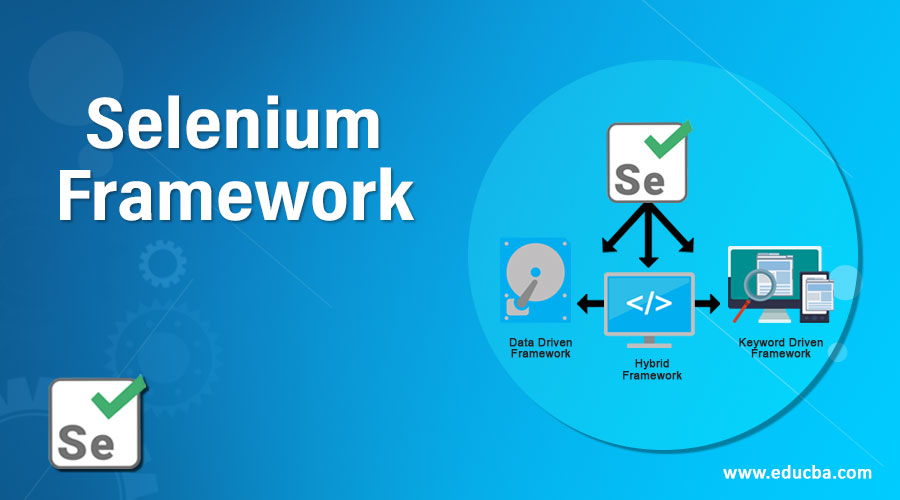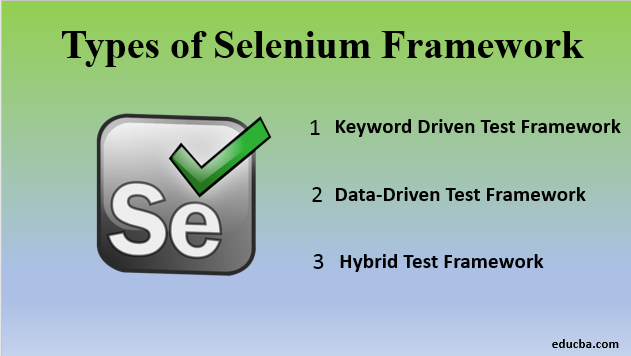Updated April 8, 2023

Introduction to Selenium Framework
Selenium Framework can be defined as a workspace formed to structure the code created for automating the testing process of a website or a web application. By using a framework, instead of a tool makes the code organization efficient, maintenance work easier, and allows multiple users to comfortably work on the same piece of the program. Selenium has a range of frameworks for Automation testing; a few of the commonly used ones are Keyword driven framework, Data-driven framework, and hybrid framework.
Understanding Selenium Framework
The biggest sweet spot that Selenium has is that it is open, which means that it is completely free to download and use. It provides an API called as WebDriver. It enables testers to craft their tests in many programming languages such as Java, Python, and C#. Though this framework is primarily used to test web browsers, it can be used to automate mobile devices like Android and iOS. The Selenium WebDriver supports major browsers which include, Chrome, Mozilla, and Internet Explorer.
Why do we Need the Selenium Framework?
Selenium Framework’s code structure helps in making code maintenance very easy. The positive outcome of using a framework is high portability. Reduce script maintenance cost, increase in code re-usage, and higher code readability.
- Reduced tests’ time execution and human resources required.
- Complete control over the tests’ results.
- Altering the test’s pre-parameters along with the data that was given, along with again testing it with other sets of data in a dynamic fashion.
The aforesaid are the other benefits of running this automated framework.
How many Types of Frameworks are there in Selenium?
There are basically three types of frameworks that have been created by Selenium WebDriver, which can automate manual test cases.
- Keyword Driven Test Framework: Here, all the operations and instructions are written in some external file Excel worksheet.
- Data-Driven Test Framework: In this framework, all the test data is generated from external files like CSV, XML or Excel.
- Hybrid Test Framework: This test framework takes advantage of both Keyword and data-driven frameworks. During this test, excel files are used as keywords that maintain test cases. Also, the data provider of the testing framework is used for test data.
Frameworks in Detail
To understand the above, we should first start with the definition of the framework. The framework can be defined as a set of rules or the best practices that are followed to achieve desired results.
Below mentioned are the components or tools of the Framework:
- Programming Language: Java + Selenium.
- IDE: Eclipse: It is an integrated development environment (IDE) for Java. This Eclipse IDE is the most popular product of the Eclipse Open Source project.
- Testing Framework: TestNG Inspired by JUnit and NUnit, TestNG is a testing framework. The new extended functionalities of TestNG have made it more powerful and easier compared to other testing frameworks. It also supports ReportNG, which is a simple HTML reporting plug-in and XLST plug-ins. This serves the purpose of customizing or extending the default TestNG reporting style. Also, it provides the ability to implement ‘IReporter’, an interface that can be implemented to generate customized TestNG reports. The ‘generateReport()’ method functions after all the other suites have completed their execution and gives the report to the specified output directory.
- AutoIT: This is a freeware scripting or BASIC scripting language which has been designed for the automation of Windows GUI and another scripting. It uses a combination of simulated keys, window control keys, and mouse movements when automating through other frameworks rather than Selenium.
- Continuous Integration: Jenkins.
File Formats which are used in the Framework:
- Properties File: Properties file is used to store and retrieve the UI elements of an application or a website and data set file paths. It also contains the id of the elements, name, XPath or the CSS selector.
- Excel Files: These files are used to pass multiple sets of data to the application.
- Xml File: This file is used to execute the test scripts. Xml files execute these scripts based on the package or classes or Tests mentioned in it.
How to Build a Framework?
It is necessary to go through these points while developing a Selenium Framework:
- Choosing a Programming Language: These languages include Java, C#, Ruby, Python, etc. In addition, Behaviour-Driven Development (BDD) could be used for executing small or short-term projects.
- Choosing a Unit Test Framework: One must select a unit test framework that would act as the base like TestNG, which is amongst the renowned unit test framework. It eliminates most of the limitations of the traditional framework and offers developers the ability to script more flexible and powerful tests.
- Designing the Framework’s Architecture: This includes building the “Selenium Core” component as well as building the “Selenium Test” component.
- Choosing a Reporting Mechanism: An efficient reporting mechanism can convert the test results into inputs that are instrumental in producing immediate corrective actions.
- Deciding how to Build, Version Control, and Implement CI/CD: This includes the Build tool and dependency managers used by the framework. The automation should focus on collaborating and sharing source code with one another. Implement well-known CI systems like Jenkins, Bamboo, TFS, etc.
- Integrating Framework with the other Tools: Integrate the framework with the help of tools like, AutoIT, TestRail, Jira, to name a few.
Conclusion
A framework is basically used to automate the testing work. These tests include testing methods like smoke testing and others. Testing can be done on web applied applications, mobile applications, and even desktops. It has been clearly established that the Selenium Framework is a kind of code structure that helps in making code maintenance easy. In simpler words, Selenium is a program or coding structured to conduct various testing programs easily and automatically. The greatest advantage of using the selenium frame is its agility in testing.
Recommended Articles
This has been a guide to Selenium Framework. Here we discuss the types of selenium frameworks and how to build a framework. You may also look at the following articles to learn more –


